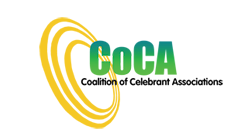C/O Department of the Prime Minister and Cabinet
PO Box 6500
Canberra ACT 2600
Australia
Email: This email address is being protected from spambots. You need JavaScript enabled to view it.
20th March 2018
Transitional Arrangements for Subdivision C and D Marriage Celebrants.
Dear Expert Panel
Thank you so much for the opportunity to present CoCA’s comments and recommendations in relation to this review.
CoCA is responding to your further request of 1st March 2018:
"As discussed last week, if CoCA happens to have any information on hand regarding the thoughts of its members on the transitional arrangements for celebrants choosing to identify as ‘religious marriage celebrants’, we would certainly be interested to share this with the members of the Panel."
CoCA considers there are a number of transitional matters that have arisen as the result of the December 2017 Marriage Act Amendments.
The issues CoCA has identified are:
1. Subdivision D celebrants are not adequately identified on the AG's website.
Former subdivision C celebrants who have chosen to move to subdivision D because of their religious beliefs are still listed on the same Register as subdivision C civil celebrants.
This is confusing for the general public since this register has the heading “Commonwealth-registered marriage celebrants who perform civil ceremonies”. The celebrants who have chosen to move to subdivision D are identified by the words “Religious Marriage Celebrant” on their individual listing.
Nothing on the register indicates that the listing "religious marriage celebrant" means that these celebrants have chosen not to conduct same sex marriages.
The public is unlikely to be aware of the difference between a civil celebrant and a "religious marriage celebrant" who performs ceremonies for independent religious organisations, that may, or may not conduct same sex marriages depending on the views of that religious organisation.
2. New Marriage Forms have introduced additional requirements related to sex an d gender identity rather than remove these.
Marriage equality amendments were designed to remove sex and gender requirements from the criteria for marriage in Australia.
However, the Attorney-General’s department has introduced additional requirements on the marriage paperwork requiring marrying couples to answer new questions about their sex and gender.
CoCA was not consulted on these forms. See Appendix 1.
3. The Attorney-General’s Department ‘guidance’ with respect to marriage paperwork, the marriage ceremony – particularly the couple’s vows, and the advertising requirements for celebrants creates confusion and anxiety for marriage celebrants, and their couples, rather than clarifying these matters.
This confusion is exacerbated by the 2-hour compulsory professional development activity that the Attorney-General’s Department has issued to be taught by the approved professional development providers to all celebrants in subdivisions C and D.
The key issues of concern in the compulsory unit are:
- an emphasis on gender identity and examples of the types of evidence Australian Government agencies accept to determine gender, implying that the marriage celebrant should seek such evidence. See Appendix 2
- an emphasis on the possible invalidity of the marriage if the vows and Monitum are not executed exactly in accordance with the department’s guidance. This emphasis is not consistent with Sections 45 (3) and (4) that emphasize the completion and issuing of the Marriage Certificates as conclusive evidence of the validity of the marriage for couples married by all authorised marriage celebrants (civil and religious). In addition, Section 48 covers any mistakes a celebrant or couple may inadvertently make, provided the couple is free to marry. See Appendix 2.
- the confusion about marriage celebrants’ advertising obligations, where the department appears to be emphasizing the exact wording of Section 39G(d). That is, “marriage celebrant vs. religious marriage celebrant” rather than the purpose of this Section in assisting the public to know whether the celebrant is a civil marriage celebrant or a religious marriage celebrant. See Appendix 3.
To address these concerns, CoCA recommends that the Marriage Act Subdivision C be amended to:
- distinguish this subdivision as Civil marriage celebrants
- clarify that there are separate registers for the different subdivisions C and D of authorised marriage celebrants
and the Marriage Act Subdivision D Religious Marriage celebrants be amended to:
- clarify a person may be authorised as a religious marriage celebrant if the person is entitled (rather than registered) to be registered as a marriage celebrant under Subdivision C of this Division; and the person is a minister of religion. (Section 39DA)
- clarify that the legislative obligation as regards advertising is to show “whether the celebrant is a civil or religious marriage celebrant” Section 39G (d).
The submission to the Religious Freedoms Panel of one of our member associations, the International College of Celebrancy Alumni and Friends, offered an example of how simply these sections of the Marriage Act (Subdivision C and D) could be amended to achieve the above.
As CoCA outlined in its Submission to the Religious Freedoms Panel:
- Unlike Subdivisions C and D, subdivisions A and B marriage celebrants are not required to do pre-authorisation training in marriage law, mandated professional development (i.e. they do not have to complete this compulsory activity) or pay an annual fee for their ongoing registration. These are inconsistencies in the Act that require attention and amendment.
- All marriage celebrants (including Subdivision A and B celebrants) will be required to complete the new marriage forms with their couples as all couples need to meet age, marital status and free and informed consent to give notice to be married.
- Subdivision A Ministers of Recognised Religions are not required to use the specific vows in Section 45 (2) nor the Monitum in Section 46 for their religious marriages. There needs to be minimum basic inclusions related to consent and the authorisation status of the celebrant in all marriages ceremonies, so all couples and all celebrants are treated equally and the nature of the legal status of the ceremony transparent to all present.
Recommendations 1 and 5 from the CoCA Submissions to the Religious Freedoms Panel would address these concerns about the different obligations of authorised marriage celebrants:
Recommendation 1:
That there be a review of, and amendments to, the Marriage Act to ensure the same basic requirements for all marriage ceremonies, whether conducted by civil or religious marriage celebrants.
Recommendation 5:
That there be a review of the regulation of all authorised marriage celebrants to improve efficiency, ensure parity across the different groups providing professional marriage services and provide a consistent and measured approach to regulation appropriate to the level of risk to the public.
Thank you for the opportunity to provide this extra information and recommendations.
Please let us know if you require any further information.
Kind regards
Dorothy Harrison
Chair - Coalition of Celebrant Associations (CoCA) Inc.
This email address is being protected from spambots. You need JavaScript enabled to view it.
Mobile: 0419 939 733
Coalition of Celebrants Association (CoCA) Inc.
http://www.coalitionofcelebrantassociations.org.a


